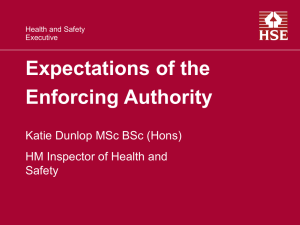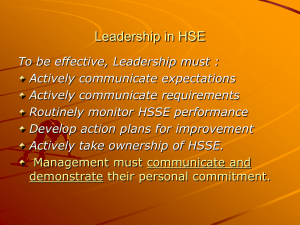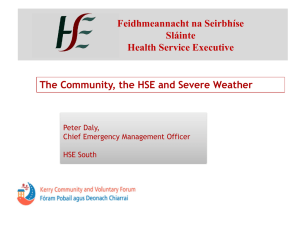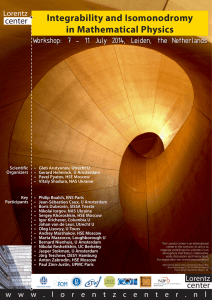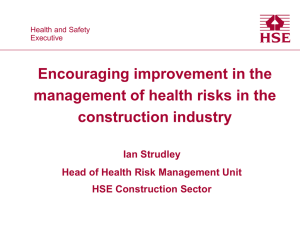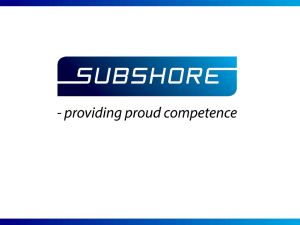Introducing a Technical HSE Framework
advertisement
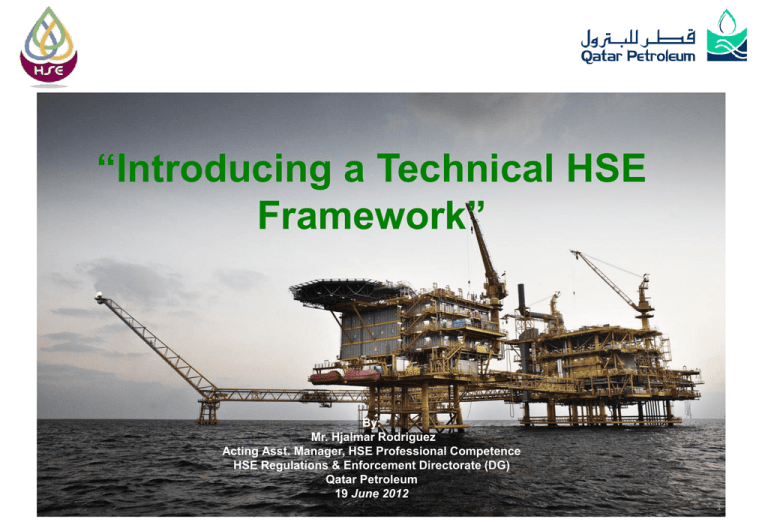
“Introducing a Technical HSE Framework” By: Mr. Hjalmar Rodriguez Acting Asst. Manager, HSE Professional Competence HSE Regulations & Enforcement Directorate (DG) Qatar Petroleum 19 June 2012 1 HSE (DG) Directorate tasks As per Decision No.5, DG Directorate key objectives (among others) are: • To control the implementation of and compliance with the laws relating to health, safety and environment…, • To organize and update the data about laws and directives; and present proposals regarding new laws or amendments to existing local laws as regards the HSE …, • To review and approve HSE programmes ... To ensure their compliance with the HSE law and the effectiveness of such regulations ..., • To assure emergency preparedness plans for significant incidents are in place and functional…,and • To issue and receive reports about the contraventions of the applicable HSE laws, to raise reports to the Minister of Energy and Industry on the state of compliance with such laws ... HSE (DG) Directorate tasks Mandated Core Function: “Assure HSE risk is regulated and controlled” HSE (DG) Directorate Roles • • • • • • • • • Provide legal guidance, interpretation and direction on HSE regulations Tasked with implementing the legal framework Monitor implementation for securing industry HSE regulatory compliance with regulations Assess treaty provisions and provide guidance on the Ratification and/or Adoption by the State of Qatar Engage all stakeholders through a review and implementation of HSE strategies Promote and monitor Sustainable and Clean Development Safeguard Qatar’s Social and Economic Development Promote HSE National Capacity Building as well as provide best practices and training DEVELOP HSE REGULATORY APPROACH with Policies, Regulations and Guidelines. Safety regulatory approach (Cont.) LEGAL STANDING • Decree Law No.4 of 1977 “Preserving Oil Wealth”. • Decision No. 5 of 2005, Chairman Board QP assigning QP’s HSE regulatory role to the Directorate. CURRENT REGULATORY STATUS • “Legal HSE Framework for the Oil & gas Industry” – issued to Energy and Industry Sector Operators as a compilation of existing national legal regulations. • “Legal Register” – listing Qatar’s legal regional/international obligations (Directorate's responsibilities). • Guidelines, standards etc. related to regulatory activities by DG. • Recent instruction by H.E. Minister of Energy & Industry to reposition the Directorate to a “Regulatory Authority” with focus on “SAFETY” for the Petroleum and Energy Sector. Technical HSE framework approach • • • • • • • • Meet the content/purpose of the existing laws of the State of Qatar Focus on Prevention of Significant HSE Risk that impacts the State level – PRIORITY, Process Safety is a key industry focus (Major Accident Hazard Prevention), Assure compliance with (regulatory) HSE obligations in close cooperation with other relevant authorities establishing focal points, MOU, agreements, etc., Influence "World Leading – Best in Class” to those with “Significant Opportunities for Improvement,” Promote the compliance and continuous improvement of HSE practices as one objective with aim to achieve shift in attitudes and requirements, Promote an improvement mentality, not a compliance mentality, Build on gathered supervision experience and lessons learned from the last few years of industry engagement. Technical HSE framework approach (Cont.) • Risk based, it requires industry operators to reduce risks to a level that is “As Low as Reasonably Practicable”(ALARP), • Goal oriented rather than prescriptive or Goal based, • Does not replace or supersede any existing regulatory requirements used in Qatar’s Petroleum and Industry, or any existing functions of any of the other State statutory authorities, • Concentrates on the technical HSE issues that will form the foundation of the operational and regulatory role for DG within the State of Qatar, • Imposes additional requirements to Petroleum and Industry activities throughout the entire life cycle of the project. Technical HSE Framework The framework focuses on the significant health, safety and environmental risks that could impact Qatar’s energy industry. THE GENERAL OBJECTIVES: • To provide a foundation for the development of HSE regulations and supplementary documents, such as Industry Guidelines/standards, in order to secure the HSE welfare of persons at work and members of the public, • To regulate Industry operators in order to reduce HSE risks to “As Low as Reasonably Practicable”(ALARP) levels, • To reduce the risks and consequences of a “Major Accident” , • To ensure a consistent use of international standards and best practices, • To implement best recognized regulatory practices in all industrial activities, and • To strengthen Qatar's preparedness and response capacity to deal with potential emergencies Technical HSE Framework SCOPE: • Independent regulation of relevant Qatari industry activities to protect life and environment; to foster and encourage safety, safety culture and continuous improvement of safety throughout the entire industrial sector. • Specified functions of the Directorate will include: i. Regulate designated activities of petroleum and industry sector with respect to HSE, ii. Monitor and enforce compliance of undertakings with their duties under Law No. 4 (1977), Law No. 8 (2004), Decision No. 20 (2005) and Law No. 30 (2002), all relevant laws and ministerial decisions, iii. Investigate and report to the Minister on Petroleum and industry incidents, iv. Issue acceptance letter to the relevant licensing authority for the issuance of Permits, and v. Provide safety information. Technical HSE Framework APPLICATION: The scope of this framework includes the following: • Oil and gas operations (upstream and downstream) within concession areas (onshore & offshore), • Chemical and Petrochemical industry, • Major storage and processing sites for hydrocarbon, petrochemicals/chemicals or other dangerous/toxic products, • Pipelines Transportation Systems, containing hydrocarbons, chemicals or other hazardous materials and/or handling high pressure, • Construction of hydrocarbon and chemical facilities and processes (onshore & offshore) • Power Generation, but not distribution, • Refining of metals (Steel and Aluminum) , • Marine – Oil tankers, LNG Carriers, MODU/Jack-up rigs, production and storage vessels (FSO/FPSO), supply and boats & vessels. Technical HSE Framework components THE COMPONENTS include: 1. A Statement of Strategic Intent 2. ALARP Demonstration 3. Agreed Interfaces, Co-operation & Co-ordination with Regulatory Authorities 4. DG’s Role in the Licensing process 5. Compliance Assurance System 6. Incident Investigation System 7. Reporting and Published HSE Information System (not everything will be shared with everybody) 8. Enforcement System 9. Continuous Improvement System Technical HSE Framework elements STANDARDS & CODES OF PRACTICE SPECIFIC DG PROCEDURES AND GUIDELINES MARINE ENVIRONMENT OCUPATIONAL HEALTH OCCUPATIONAL SAFETY THIRD PARTY CERTIFICATION ASSET INTEGRITY WELL DESIGN & CONSENT OFFSHORE INSTALLATIONS MAJOR HAZARDS TECHNICAL HSE FRAMEWORK Int’l Standards : • e.g. ISO, IEC • e.g. CEN (Europe) • e.g. ANSI/API (US), DIN (Germany) or NEN (NL) Industry Standards: • OGP, IADC, IMCA, API • Nogepa, OLF, UK oil & gas Technical HSE framework components INDUSTRY REGULATION, INTERFACES AND CO-OPERATION • Should focus on safety, without disregarding any case related to the areas of health and environment. Primary focus will be on preventing major incidents. • Strong working relationships shall be established with other government HSE Regulatory duty holders (i.e. MoE, MoL, SCoH) to avoid duplication and to complement their activities. • It is consistent with other best practices and other regulatory regimes which minimizes duplication of regulatory activities. 13 Interfaces, Cooperation & Coordination with Regulatory Authorities MoEI ENVIRONMENT ENVIRONMENT MoEI ASSET INTEGRITY WELL DESIGN & CONSENT OFFSHORE INSTALLATIONS MoEI MARINE MoEI OCCUPATIONAL SAFETY SCoH 3RD PARTY CERTIFICATION LICENSING AUTHORITY SAFETY MAJOR HAZARDS REGIME OCCUPATIONAL HEALTH HEALTH HSE REGULATIONS MoEI MoL, Civil Def. Ports, MoI MoE Technical HSE framework components DG’S ROLE IN THE LICENSING PROCESS • DG will regulate designated Petroleum and Industry activities through the Ministry of Energy and Industry licensing system • Petroleum and industry Operator will only be able to undertake activities upon approval of a license to be issued by the relevant regulatory body upon DG’s acceptance of a pertinent Major Hazards Report (MHR) or Safety Case (SC). 15 Technical HSE framework components COMPLIANCE ASSURANCE SUPERVISION • Monitor the compliance of operator(s) in accordance with Technical HSE Framework and its associated regimes, permits or licenses and the general duties of the Operator as per existing HSE regulations of the State. • Include a process of inspection, supervision, verification and performance reporting requirements by Directorate (DG) personnel. • The frequency of supervision visits shall be based on the size and nature of the operation, number of personnel, past audit outcomes and perceived safety risk of the Operators. • Propose enforcement actions and compensations determined by law, in the event that an Operator is not complying with its obligations and its approved permit (s). 16 Technical HSE framework components INCIDENT INVESTIGATION SYSTEM • Decision No. 5 (2005) by the Chairman of Board of Directors of QP placed the responsibility on DG to investigate serious industrial accidents, and to head investigation committees in this regard. • Under this framework, Industry Operators shall notify DG of any major incidents (i.e. phone call, email, and fax). • DG may in co-operation with other Governmental Agencies investigate certain incidents . • Directorate (DG) may: – Request the Industry Operators to furnish a Incident Report; and/or – Appoint a designated staff to investigate the incident; and/or – Issue an improvement notice, a prohibition notice, a notice requiring the Industry to revise procedures and systems 17 Technical HSE framework components CONTINUOS IMPROVEMENT SYSTEM • Based on measurement of the HSE outcomes and overall safety performance of industry operators. • Inputs to the continual improvement process: – HSE Performance reporting by Qatar’s industries, – Findings and recommendations from the supervision and verification process, – Information and outcomes from enforcement actions, – Administrative areas that requires attention, – Areas of duplication regarding inspections and reporting, – Identified common HSE trends within industry, – Information from co-operation and co-ordination of regulatory activities, – Lessons learned from incident investigations. 18 Technical HSE Framework Highlights GENERAL COMMENTS: • Operators welcomed publication of the Technical HSE Framework and its regimes: – Clarification of the role of HSE-DG in regulating Major Accident Hazard Management, Offshore Installations, Well Integrity/Consent, Asset Integrity Management and Third-party Certification. • Potential opportunity to share operator's experience with DG in Major Hazard, Well Consent and Asset Integrity Management: – Upfront conformation of Working Groups with Industry in developing documents. • Many comments in clarification and restructuring of document. 19 Technical HSE Framework Highlights SPECIFIC COMMENTS: • Third Party Certification should not be considered as a Third Party Verification Regime. • Provision of requirements on emergency response coordination and management at individual level and then city level (ref: MHR). • Some existing industries do not comply with current codes of practice and standards. • DG cannot require a regulated entity to “exceed” a standard without setting a new standard. • Specific obligations and details in regimes (e.g. to obtain a permit, license and to report incidents to DG) should not be part of THSEF. 20 Technical HSE Framework Highlights SPECIFIC COMMENTS: • Consider excluding pandemic, epidemic, disease and food poisoning on major scale as major accident hazards. • Suggest that off-shore facilities are separated from on-shore facilities in terms of regulative requirements: – Reason being - Offshore Safety Cases are normally vigorous documentation of compliance that an operator meets requirements for integrity for helicopter. transport, accommodations, safety critical elements, etc. • Consult with Operators for the development of procedures, as well as the enforcement system to get valuable feedbacks on areas of concerns from the operator: – Incident Reporting and Investigation, – HSE-MS, – Risk Acceptance Criteria, as part of Risk Management. 21 Technical HSE Framework Highlights SPECIFIC COMMENTS: • Consider including Security of Offshore and Onshore facilities in the scope of this Framework. • Care should be taken in defining the frequency, depth and issuance of licenses and permit renewal. • Potential involvement of External consultant in development of implementation documents (guidelines, reporting tables, working instructions etc.) – under process • Linking “Report” Acceptance to existing MoE&I Licensing Process: – Need for resources to cope with the review and assessment. – Potential delays in projects due to slow/late licensing process. – DG would have to get the right expert resources to be able to satisfy the demand. 22 Expected (Planned) Activities 1. Conformation of working groups with subject matter experts (SME’s) from industry 2. Review and feedback for Offshore Installations Regime and Well Integrity and Well Consent Regime. 3. Finalization of 2 remaining regimes (as per plan). 4. Host a 2nd Workshop. 23 Concluding statement: “The State of Qatar will continue to build upon its role in the regional and international community as a stable and reliable partner in Energy and Industry Sector by implementing HSE culture based on the highest international standards and best approach. The HSE (DG) Directorate will do its outmost best to contribute to this effort” Thank you for your attention!

